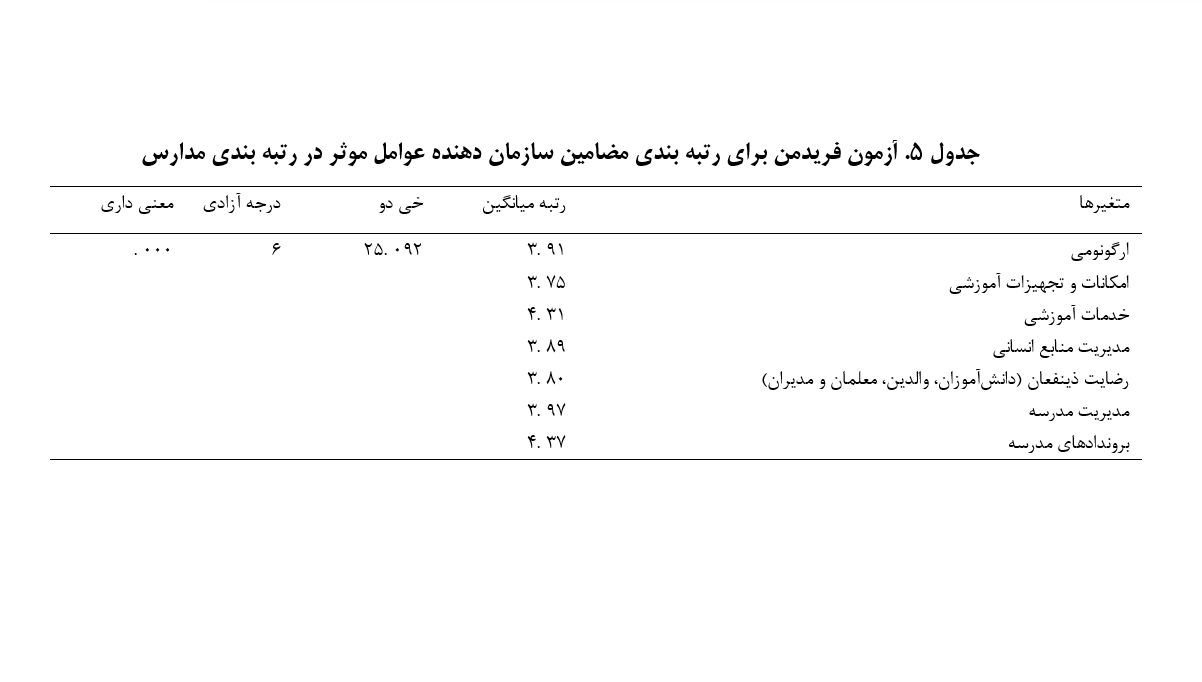شناسایی و اولویت بندی عوامل موثر در رتبه بندی مدارس عراق از دیدگاه ذینفعان
کلمات کلیدی:
رتبه بندی مدارس, رتبه بندی از دیدگاه ذینفعان, مدارس کشور عراقچکیده
پژوهش حاضر به شناسایی و اولویت بندی عوامل مؤثر بر رتبه بندی مدارس در آموزش و پرورش عراق از دیدگاه ذینفعان پرداخته است. این مطالعه به روش کیفی-کمی و با مشارکت گروههای مختلف شامل مدیران مدارس، معلمان و اعضای انجمن اولیا و مربیان انجام شده است. در مرحله کیفی، با استفاده از مصاحبههای نیمهساختمند و تحلیل مضامین، عواملی که بر رتبهبندی مدارس تأثیر دارند استخراج و به کدهای اولیه و مضامین پایه تبدیل شدند. سپس با دستهبندی این مضامین، مضامین سازماندهنده و یک مضمون فراگیر شکل گرفت. برای اعتبارسنجی مدل، روشهای مختلفی مانند بازخورد به مشارکتکنندگان و بررسی منابع علمی مورد استفاده قرار گرفت. اعتمادپذیری یافتهها نیز از طریق نظرات کمیته راهنما و محاسبه CVI و CVR تأیید شد. در بخش کمی، یک پرسشنامه تنظیم و در اختیار 282 نفر از مدیران، معلمان و اعضای انجمن اولیا و مربیان قرار گرفت. با استفاده از آزمون t تک نمونهای، میزان موافقت اعضا با عوامل استخراجشده مورد سنجش قرار گرفت و در نهایت، رتبهبندی این عوامل با آزمون فریدمن انجام شد. نتایج نشان داد که در مجموع 76 مضمون شاخص در قالب 10 مولفه (ارگونومی، امکانات و تجهیزات آموزشی، خدمات آموزشی، مدیریت منابع انسانی، رضایت ذینفعان (دانشآموزان، والدین، معلمان و مدیران، مدیریت مدرسه، بروندادهای مدرسه) شناسایی و اولویت بندی شد.
دانلودها
مراجع
Cheng Y-C. A Typology of Multiple School Leadership. Education Sciences. 2024;14(1):70. doi: 10.3390/educsci14010070.
Abella J, Kilag OK, Andrin G, Tañiza FN, Groenewald E, Cordova Jr N. Literacy Leadership in Elementary Schools: The Connections between Principal Practices and Reading Performance. Excellencia: International Multi-disciplinary Journal of Education. 2024;2(1):69-78.
Zare Banadkouki MR, Vahdat Zad MA, Olya MS, Lotfi MM. Pathology of university ranking systems from the perspective of higher education superordinate documents in Iran. Educational Management Research. 2017;20(1):52-87.
Hassani R, Jamali A, Taghipour Zaheer A, Rahgozar M. Construction and factor analysis of the measurement model for ranking the country's secondary schools. Educational Management Research. 2017;32(8):41-63.
Delaney JM, Devereux PJ. High school rank in math and English and the gender gap in STEM. Labour Economics. 2021. doi: 10.1016/j.labeco.2021.101969.
Bozorginejad K, Zarei R, Amirianzadeh M, Kheir M. Identifying criteria and indicators for ranking private schools from the perspective of strategic factors. Scientific Quarterly Journal of School Management. 2020;8(1):1-15.
Rah Najat M, Negarestani MH. Examining Educational Justice in Light of the Law on the Establishment and Management of Private Schools and Educational Centers. Public Policy Quarterly. 2024;10(1):143-57.
Joshi P. The growth, roles and needs of the private education system: Private stakeholder perspectives from Nepal. International Journal of Educational Development. 2019;65:57-67. doi: 10.1016/j.ijedudev.2019.01.002.
Marques M, Powell JJ. Ratings, rankings, research evaluation: How do schools of education behave strategically within stratified UK higher education? 2019. doi: 10.1007/s10734-019-00440-1.
Anderson T, Blom E, Lindsay C. Identifying high-performing schools for historically underserved students: Urban Institute; 2020.
Delprato M, Chudgar A. Factors associated with private-public school performance: Analysis of TALIS-PISA link data. Educational Development. 2018;61:155-72. doi: 10.1016/j.ijedudev.2018.01.002.
Sammons P, Gu Q, Day C, Ko J. Exploring the impact of school leadership on pupil outcomes: Results from a study of academically improved and effective schools in England. International Journal of Educational Management. 2011;25(1):83-101. doi: 10.1108/09513541111100134.
Requier F, Fournier A, Rome Q, Darrouzet E. Science communication is needed to inform risk perception and action of stakeholders. Environmental Management. 2020;257:109983. doi: 10.1016/j.jenvman.2019.109983.
Zardasti L, Yahaya N, Noor NM, Valipour A. Quantifying reputation loss of pipeline operator from various stakeholders' perspectives-Part 1: Prioritization. 2020. doi: 10.1016/j.jlp.2019.104034.
Pasquier U, Few R, Goulden MC, Hooton S, He Y, Hiscock KM. "We can't do it on our own!"-Integrating stakeholder and scientific knowledge of future flood risk to inform climate change adaptation planning in a coastal region. Environmental Science & Policy. 2020;103:50-7. doi: 10.1016/j.envsci.2019.10.016.
Barrett P, Treves A, Shmis T, Ambasz D, Ustinova M. The impact of school infrastructure on learning: A synthesis of the evidence: The World Bank; 2019.
Mirkamali SM, Saadati Tabar F. Investigating the satisfaction of stakeholders with the in-service training process in the Industrial Development and Renovation Organization of Iran. Training and Human Resource Development. 2015(7):101-23.
Pineo H, Moore G. Built environment stakeholders' experiences of implementing healthy urban development: An exploratory study. Cities & Health. 2021:1-15. doi: 10.1080/23748834.2021.1876376.
Chilton AS, Masur JS. What should law school rankings measure and how should we measure it: A comment on Heald & Sichelman's rankings. Jurimetrics. 2019.

دانلود
چاپ شده
ارسال
بازنگری
پذیرش
شماره
نوع مقاله
مجوز
حق نشر 2025 نشریه پژوهش و نوآوری در تربیت و توسعه

این پروژه تحت مجوز بین المللی Creative Commons Attribution-NonCommercial 4.0 می باشد.










